Samsung offers two top models with 4K resolution when it comes to MiniLED technology. In this test, we took a closer look at the perhaps not so "high-end" QN95D, but rather the QN90D, which can also be found under the name QN92D. Samsung proudly calls its MiniLED televisions the NeoQLED series. It is precisely because of this technology that the television offers excellent contrast and high brightness, making movie watching an experience reminiscent of a true cinema. During everyday use, the Tizen system performed excellently. It is fast, intuitive, and allows seamless switching between applications. We also appreciated how well the television managed lower quality materials – traditional television and older films looked better than we expected, and the advanced image processing algorithms did their job. This is a television that truly enhances the reception of content that is not always in high resolution. The solar remote was a pleasant surprise for us. Although minimalist and with a limited number of buttons, it proved to be very practical – allowing us to control not only the television but also other devices, such as the decoder (Canal+) and the soundbar. This meant we could reduce the number of remotes on the table, which immediately improved usability. Additionally, solar charging – a simple idea that eliminates the need for battery replacements and aligns with ecological trends. As for the picture in different conditions, the television performs well in both bright and dark rooms. High brightness and numerous dimming zones handle most content, although sometimes in contrasty scenes a halo effect is visible. The colours are vibrant and natural, and the QLED coating adds intensity to them. For even better results, we opted for calibration – after which the picture looked even more detailed and natural, which only reinforced our belief that the QN92/QN90 is an excellent choice. And what about motion on the screen? It is absolutely smooth. The 144 Hz panel performs excellently with dynamic scenes – fast actions, sports, games – everything looks natural and without blurring. We particularly appreciated the Auto Motion Plus Game feature, which makes games running at 30 frames per second look smoother, resembling 45 frames, and at 60 Hz, motion becomes even more natural, as if operating at 90 Hz. For gamers, this is a significant advantage, especially since low input lag and features like game bar further enhance the gaming experience. This is a television that will perform well in any situation – from evening screenings to gaming marathons. The QN92D is a practical television, well-designed, and offering picture quality that is truly hard to ignore. An ideal choice for those looking for something more than just an ordinary screen for everyday content.
- Matching (Score)
- Our verdict
- TV appearance
- Where to buy
- Contrast and black detail
- HDR effect quality
- Factory color reproduction
- Color reproduction after calibration
- Smoothness of tonal transitions
- Image scaling and smoothness of tonal transitions
- Blur and motion smoothness
- Console compatibility and gaming features
- Input lag
- Compatibility with PC
- Viewing angles
- TV efficiency during daytime
- Details about the matrix
- TV features
- Apps
- Playing files from USB
- Sound
Samsung Neo QLED QN90D / QN92D vs TCL C8K
Direct compare
Neo QLED / QN92D / QN90D
C8K / QM8K

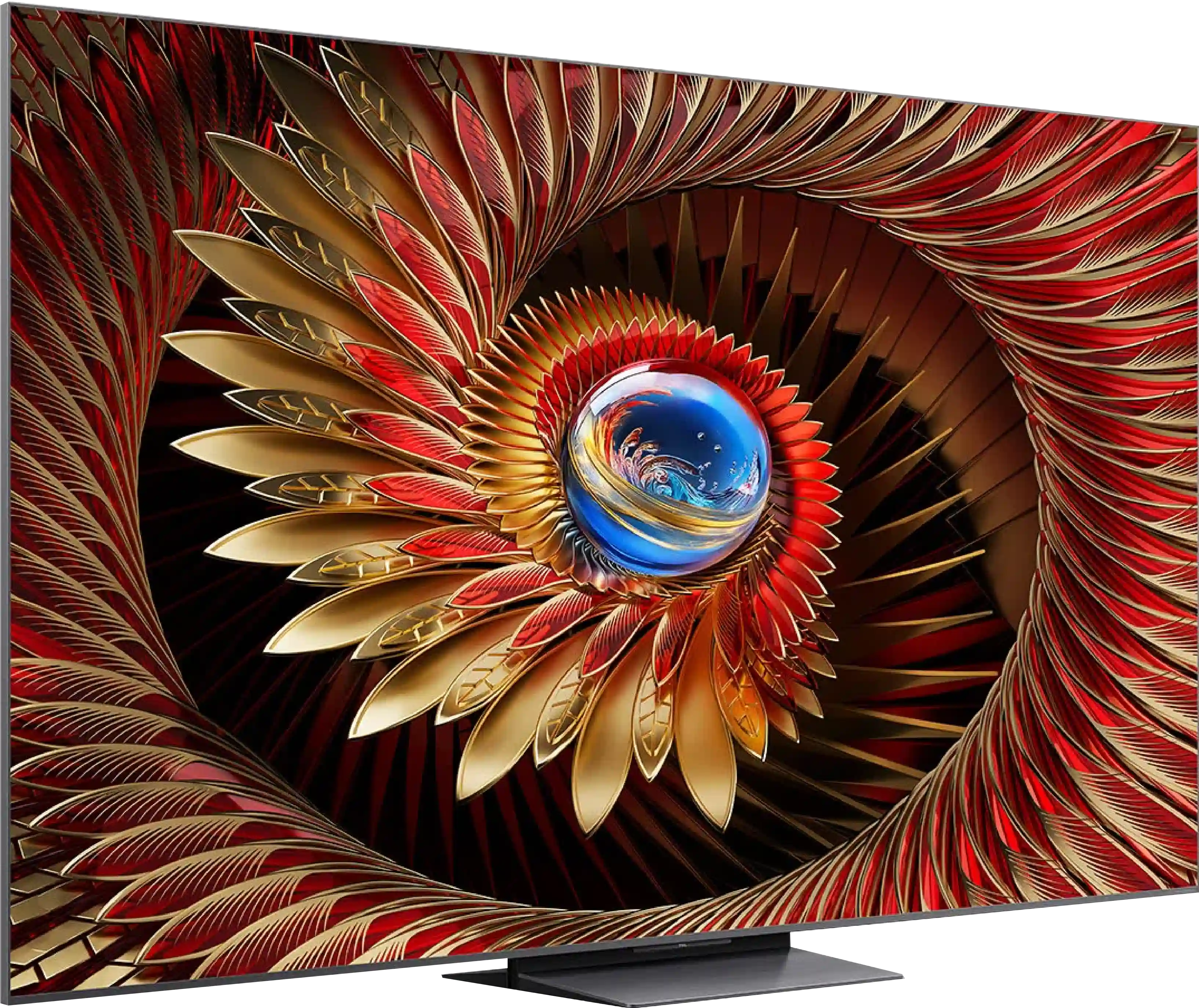
Panel type: LCD VA (wide viewing angle)
Resolution: 3840x2160
System: Tizen
Model year: 2024
Complete the survey to find out the result

Panel type: LCD VA
Resolution: 3840x2160
System: Google TV
Model year: 2025
Complete the survey to find out the result

Overall rating
7.8
7.7
Movies and series in UHD quality
7.9
7.4
Classic TV, YouTube
7.9
7.0
Sports broadcasts (TV and apps)
7.7
6.8
Gaming on console
9.1
8.9
TV as a computer monitor
8.6
8.6
Watching in bright light
6.4
6.9
Utility functions
7.4
7.7
Apps
8.7
9.6
Sound quality
6.9
7.9
Complete the survey to find out what fits your preferences
Advantages
High brightness
Good contrast
Intuitive Tizen operating system
Great for gamers and sports fans (HDMI 2.1, 144Hz, low input lag)
Wide viewing angles - unusual for VA panels
Great contrast and black levels
Very high HDR brightness
Support for all popular HDR formats
Fast 4K@144 Hz panel
Many features for gamers (VRR, ALLM, Game Bar, Low input lag)
GoogleTV operating system with multiple apps
Improved viewing angles thanks to WHVA panel
Very good sound: Collaboration with Bang & Olufsen
Disadvantages
No recording function
No DTS format support - this may be problematic for those using Blu-ray
No smaller variants such as 55"
Very weak dimming algorithms
Colour reproduction out of the box needs improvement
Only 2 HDMI 2.1 ports and one USB.
No recording function from built-in tuners or PiP
Our verdict
The C8K is proof that premium Mini LED technology does not have to cost as much as a premium product. With a high number of dimming zones and a new WHVA panel, the television offers excellent contrast, deep blacks, and very high brightness – everything we expect from a good viewing experience in the living room. The improved viewing angles are also surprising, finally allowing us to enjoy watching even when sitting outside the centre of the frame. The C8K also excels in the gaming world – 144 Hz, support for 288 Hz in Full HD, a complete set of gaming features, very low input lag, and sensible compatibility with PCs make it hard to tear ourselves away from it with a controller or keyboard in hand. Onboard, we also have Google TV – currently the most advanced and versatile Smart TV platform. There is access to all key applications, excellent voice control, and an intuitive interface. It may lack some classic TV features like USB recording from built-in tuners or picture-in-picture (PiP), but most users won't even notice that. On top of all this, there is very decent sound – a new collaboration with Bang & Olufsen.
Of course, it is not a screen without flaws. HDR, although impressive, still carries some 'mini LED' traits – bright scenes can be overly bright or dimmed, and the system lacks a few classic features known from other brands. But when we look at its price compared to the competition, it’s hard not to ask ourselves – why pay more?
TV appearance






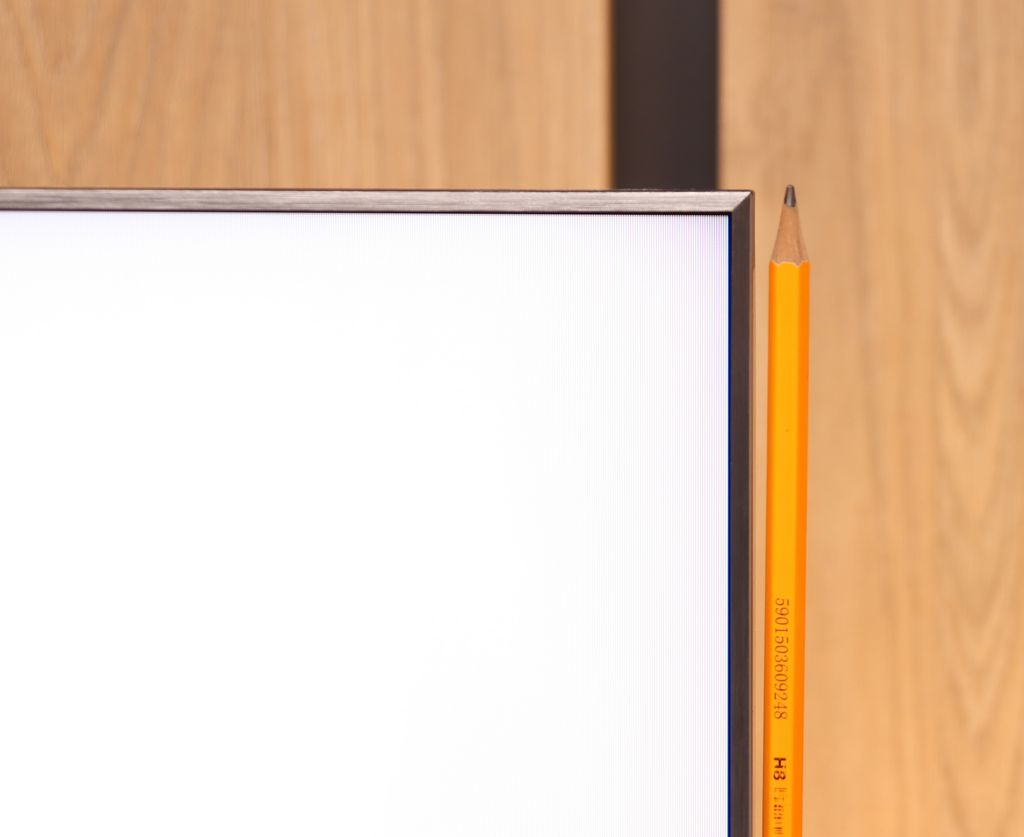
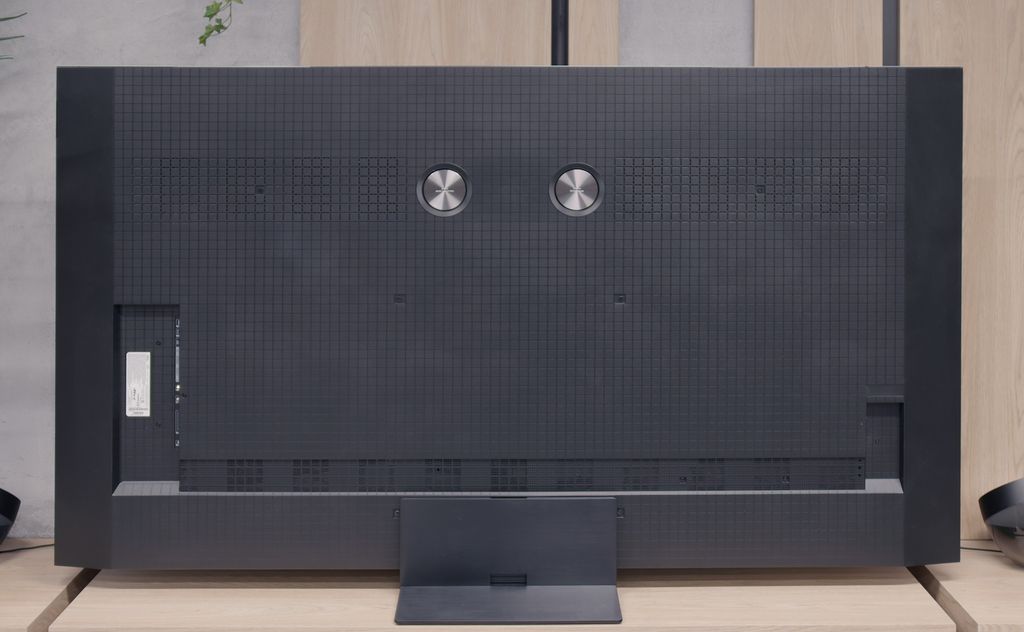
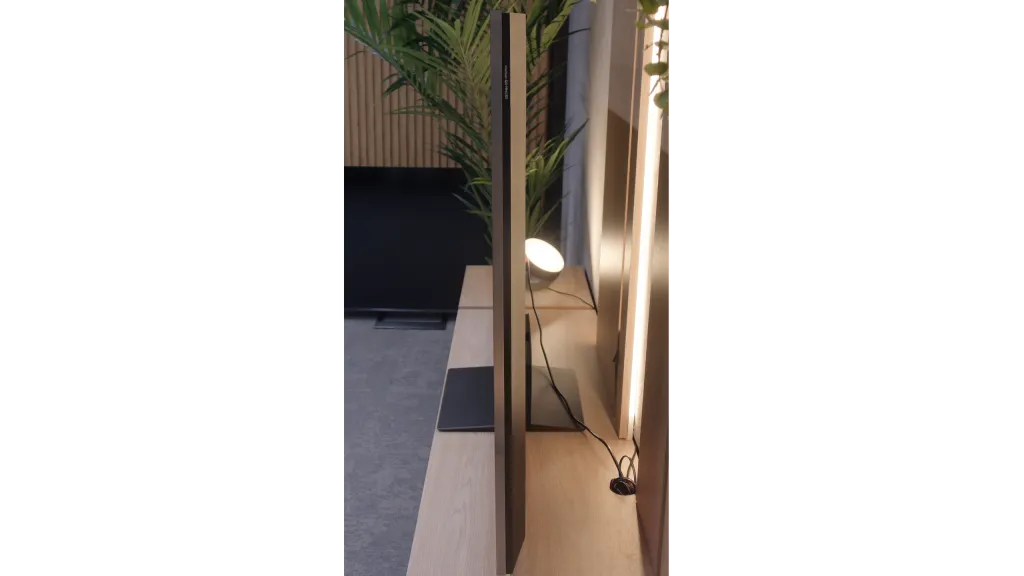
Contrast and black detail
7.9/10
8.2/10
Local dimming function: Yes, number of zones: 504 (36 x 14)
Local dimming function: Yes, number of zones: 1680 (30 x 56)
Contrast:

Result
∞:1

Result
69,000:1

Result
∞:1

Result
5,500:1

Result
2,700:1

Result
714,300:1

Result
68,100:1

Result
25,050:1

Result
17,800:1

Result
12,500:1
Halo effect and black detail visibility:

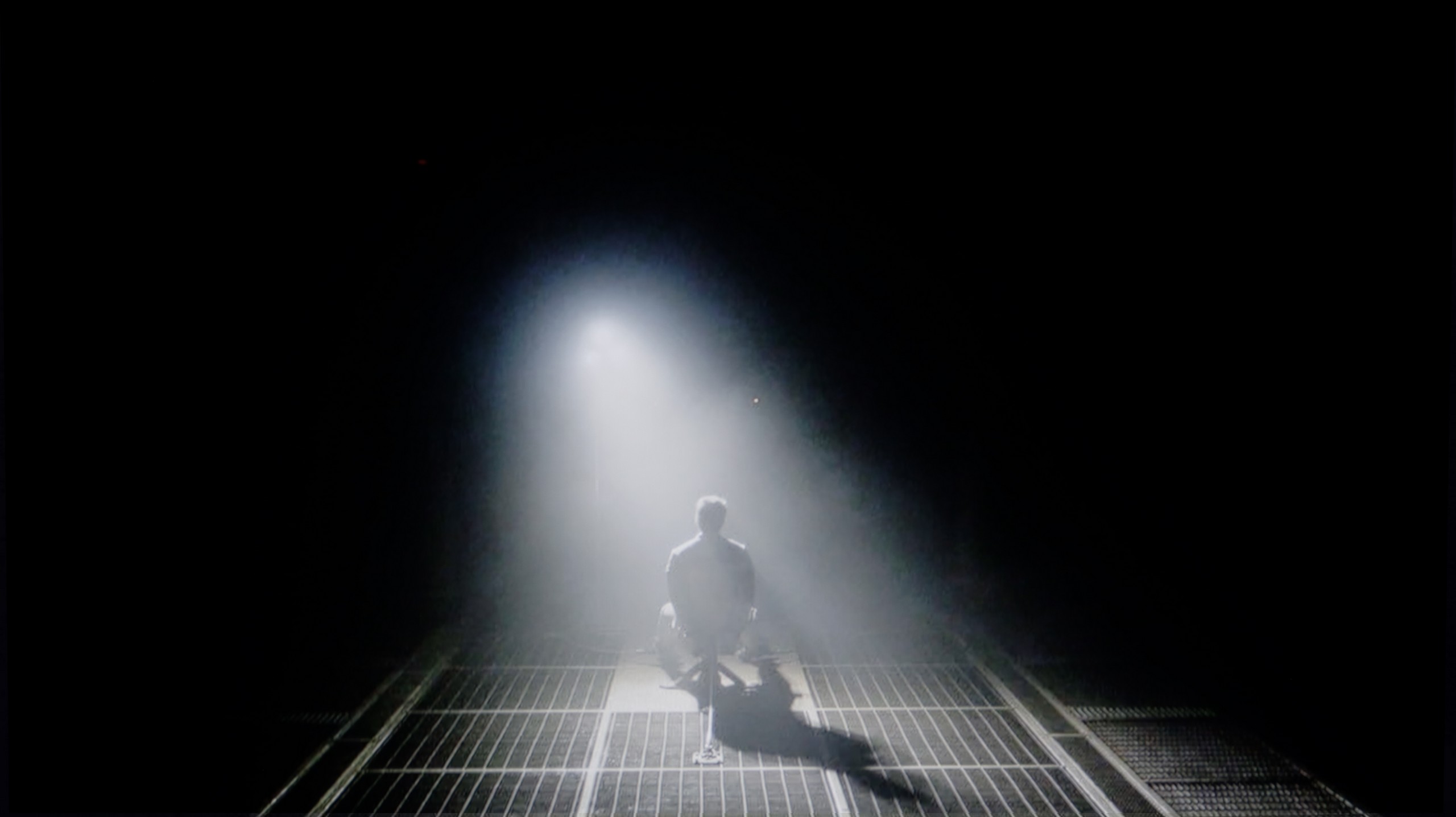
Samsung QN92D is one of the highest models of NeoQLED 4K (mini LED) from the Korean manufacturer for 2024. Although it does not offer as many local dimming zones as its more refined sibling Samsung QN92D, the number of 504 dimming zones in the 55-inch version is still impressive. The VA panel works well with this solution, providing excellent results in terms of contrast. The contrast in Samsung QN92D is outstanding for a non-OLED television. Even in challenging scenes, like those from the films "Oblivion" or "Arrival", the contrast is nearly infinite and can compete with the best televisions in the OLED segment, which is quite rare among LED-backlit televisions. However, mini LED technology has its limitations compared to organic panels, which can lead to certain issues. For example, on the latest test pattern from Pioneer, the television struggles significantly. This may be due to a very aggressive dimming algorithm, causing the mini LED lights to sometimes be unable to "decide" what to do – whether to illuminate certain elements or maintain black levels. Despite these shortcomings, Samsung QN92D is one of the best LCD televisions in terms of contrast and black levels.
TCL C8K is a representative of Mini LED televisions and – importantly – uses a VA panel. This means high native contrast right from the start, but the true strength of this model reveals itself only when we combine it with an impressive number of dimming zones. In the 75-inch version we tested, we counted nearly 1700 independent zones – and you can feel it. In many scenes, the effect of black levels and contrast is nothing short of phenomenal. In less demanding scenes – where the dimming algorithms do not have to 'struggle' much – the screen can resemble OLEDs. The contrast can be almost infinite, and the separation of bright and dark elements leaves an excellent impression.
However – as is often the case with Mini LEDs – it is not an organic screen and some compromises must be accepted. Brightness is a significant advantage, but also a factor that can reveal the weaknesses of this solution – especially in dark scenes. In particularly challenging scenes to display – such as those famous ones with a starry sky or sequences from the iconic Pioneer Kuro – the so-called halo becomes noticeable, which is a glow around small bright details. Sometimes the entire screen also slightly brightens when the system tries to balance contrast with extreme luminance. However, this is a feature of the technology, not a flaw of the specific model. And although these types of compromises can slightly diminish the overall impression in certain scenes, TCL C8K is among the very best when it comes to contrast among Mini LED televisions.
HDR effect quality
6.7/10
6.9/10
Luminance measurements in HDR:

Result
1947 nit

Result
617 nit

Result
738 nit

Result
271 nit

Result
1479 nit

Result
1241 nit

Result
510 nit

Result
1180 nit

Result
375 nit

Result
1421 nit
Scene from the movie “Pan” (about 2800 nits)


Scene from the movie “Billy Lynn” (about 1100 nits)


Static HDR10


Dynamic: HDR10+
Dynamic: Dolby Vision


HDR luminance chart:
TCL C8K
HDR luminance
Samsung Neo QLED QN90D / QN92D
HDR luminance
During synthetic tests, Samsung QN92D displayed its incredible capabilities in terms of brightness. The graphs clearly indicate that the television can achieve an impressive 2000 nits, giving it a solid power base to compete with the best models on the market. Such a result places it at the forefront, especially in the context of displaying HDR content, where brightness plays a crucial role. However, what happens when we transfer the tests to real film scenes? Under favourable conditions, such as the first scene from the film Life of Pi or the last scene where the image is entirely flooded with light, Samsung QN92D can achieve nearly laboratory results, impressing with its brightness. The situation looks different, however, when small, bright objects appear on a dark background, as in the fourth scene from the film Sicario. In such cases, the television does not perform as well – brightness drops several times, and the maximum values under the best conditions are around 600 NITS. Similar to the case with contrast, these limitations arise from the use of an aggressive local dimming algorithm. This algorithm aims to reduce the 'halo' effect around bright objects on a dark background, but often at the expense of overall brightness. As a result, while the television excels in brightly lit scenes, its ability to display full brightness is limited when it comes to small, vivid elements.
The TCL C8K is a truly bright television. In synthetic conditions – that is, during brightness test patterns – it was able to achieve even 3500 nits of peak brightness in movie mode. This is an impressive result that brings the C8K close to the market leaders, at least in terms of panel brightness. More importantly – these are not just numbers on paper. In films with a lot of bright scenes, such as Life of Pi or The Meg, the brightness clearly exceeds 1000 nits, providing a real sense of HDR effect. The picture in such moments looks very dynamic, colours are vibrant thanks to excellent colour gamut coverage, and lights are spot-on and intense. Just as it should be.
However, this does not mean that everything is perfect. Similar to the contrast tests, compromises also arise here in more demanding scenes. In sequences with very fine light elements – such as stars in the night sky or reflections in dark rooms – the local dimming algorithm can… get confused. Instead of bringing those details up, the television sometimes decides to significantly dim them – to a level of around 300 nits – to maintain blacks. On one hand, this is quite a reasonable approach (better deep blacks than a grey/blue screen), but on the other hand – there may be moments when certain elements of the picture become hardly visible or even disappear into darkness.
TEST UPDATE (20/08/2025) : The brightness control algorithm in this model is quite problematic – an attempt to calibrate the picture so that it does not drastically overexpose the brightest scenes results in unnatural shifts: an improvement in one area of the picture leads to a deterioration in another. The television may achieve slightly higher brightness measurements, but in practice, this comes with a highly oversaturated image that looks very unnatural!
For the sake of order, we provide the brightness values without this adjustment:
1463 nits
640 nits
1368 nits
468 nits
1025 nits
Factory color reproduction
6.1/10
4.8/10


Factory Mode
After calibration


Factory Mode
After calibration
The best mode that consistently reproduces colours on the Samsung QN92D is, as it has been for years, the Filmmaker mode. Although it generally offers decent colour quality, it is not without significant issues. Let’s start with the analysis of images in HD/SDR quality. The biggest challenge here is white balance – the graphs show considerable instability, with a pronounced red dominance, making the image too warm. This distortion causes shades to be unnaturally shifted towards warmer tones, which can negatively affect the perception of materials with natural colours. The contrast, based on the gamma graph, although not the worst, remains far from ideal, impacting the overall image quality, especially in darker scenes.
This problem persists with 4K materials, such as series or movies of higher quality. In this case, the white balance also proves faulty, with noticeable deficiencies in blue and red colour, leading to tonal shifts. Tests using the Colour Checker tool confirm these issues – all colours tend to shift towards yellow tones, further distorting the natural appearance of the image. Although the Filmmaker mode is one of the best available modes for watching cinematic content, it still requires improvements, especially concerning colour accuracy and white balance.
In the C8K, a new picture mode has appeared: Filmmaker Mode. This is something we have known for years from televisions of other brands – a mode designed to deliver the director's vision as faithfully as possible, without unnecessary image enhancements. Unfortunately, with TCL, this still seems to be at a stage 'in need of improvement'. At first glance, the screen appears too warm – the image leans towards reds, which may not appeal to everyone. The white balance was significantly skewed – the screen looked distinctly warm, and the red colour dominated almost every scene. There was a lack of blue, which resulted in an unpleasant yellowing and distortion of the image. But that’s not all. Regardless of whether we were watching regular television, YouTube, or films in HDR – the television had a clear tendency to excessively brighten the image. In the gamma and EOTF graph tests, the lines, instead of sticking to the pattern, strayed, which in practice translates to an overly bright and less contrasty image. Additionally, in the colour reproduction tests, there were noticeable deviations – on the colour wheel, certain points were even 'off the mark'. It must be said plainly: Filmmaker Mode in the C8K in its current form is not very filmic.
Color reproduction after calibration
8.7/10
7/10

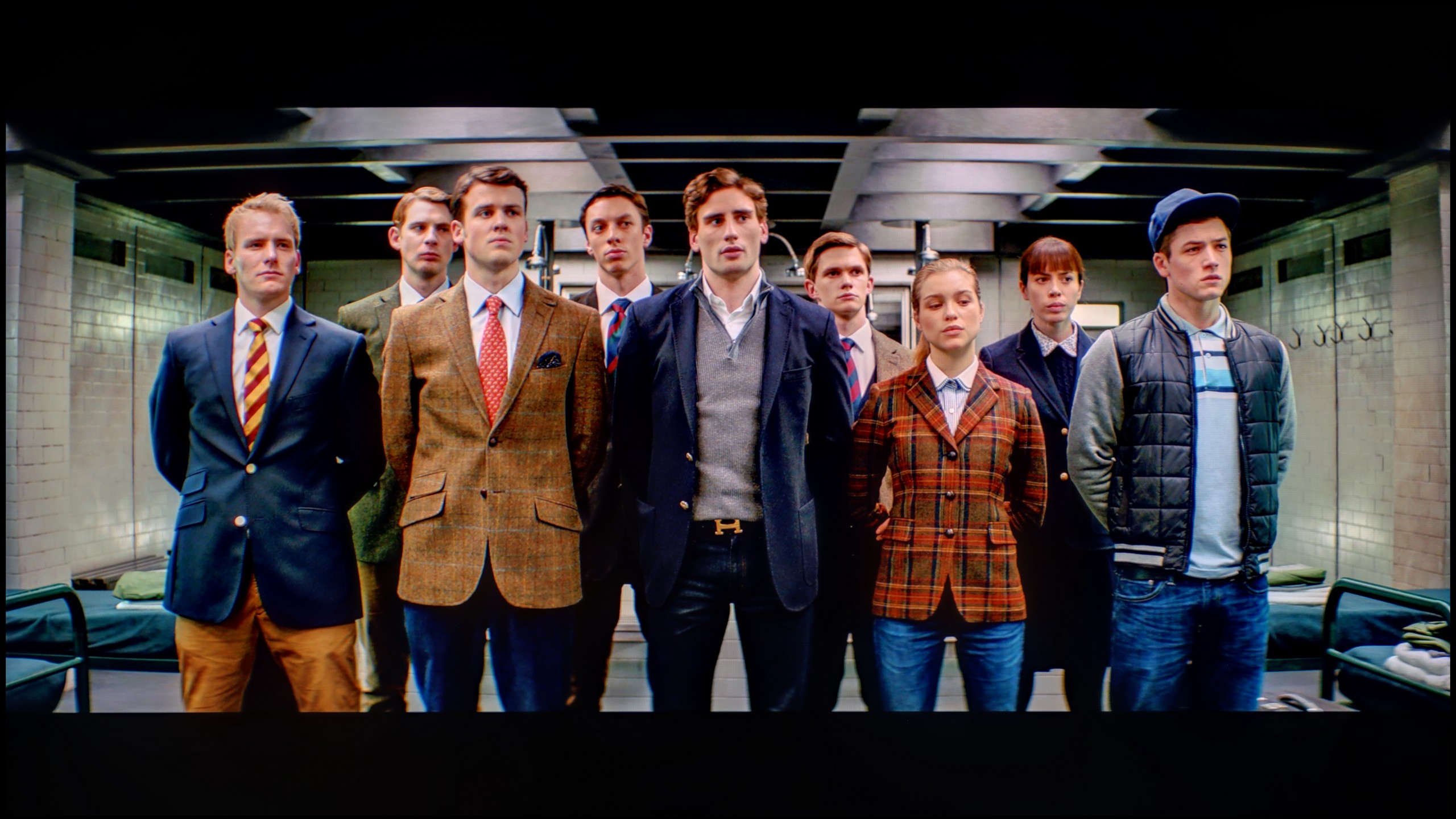


After calibration, the Filmmaker mode on the Samsung QN92D television shows significant improvement, particularly in terms of SDR content. The white balance has been greatly enhanced – the previous colour misalignment and dominance of red have been eliminated, resulting in a more natural colour reproduction. In terms of brightness, although the gamma chart did not require significant adjustments, it has been stabilised, which affects overall picture quality.
Regarding high-quality materials, the white balance has also improved in this case. However, it is important to note the contrast. The EOTF curve, which illustrates values in this area, initially seems correct. However, when we look at the details, the television struggles to maintain appropriate contrast in film materials. The EOTF curve reveals certain discrepancies, suggesting that despite advancements, there are still areas needing improvement in this aspect. The television still strives for excellence in contrast reproduction. One advantage of this television is colour saturation. Skin tones are rendered very well, and although some colours can be slightly oversaturated, the final effect looks truly appealing – the colours appear rich and vibrant.
Despite some shortcomings in contrast, after calibration, the Filmmaker mode on the Samsung QN92D offers excellent picture quality, with natural colour reproduction, making it a great choice for watching films.
After professional calibration, the TCL C8K has made a huge step forward. In SDR content, we managed to almost perfectly set the white balance – the screen has finally stopped being too warm and has acquired a neutral character. The gamma curve, responsible for the way brightness is reproduced, also looks very good now – the image is more consistent and realistic. We also improved the white balance in HDR content – within the limits that the television itself allows. Unfortunately, the C8K still interprets brightness management somewhat "in its own way." When we look at the EOTF chart in films, it is clear that the television brightens entire scenes more than it should. Before calibration, this effect was really troublesome – now the situation looks much better, although it still falls a bit short of perfection. This, however, is a limitation of the device itself, which – despite our efforts – does not allow us to fully tame its nature.
Smoothness of tonal transitions
9/10
8.7/10





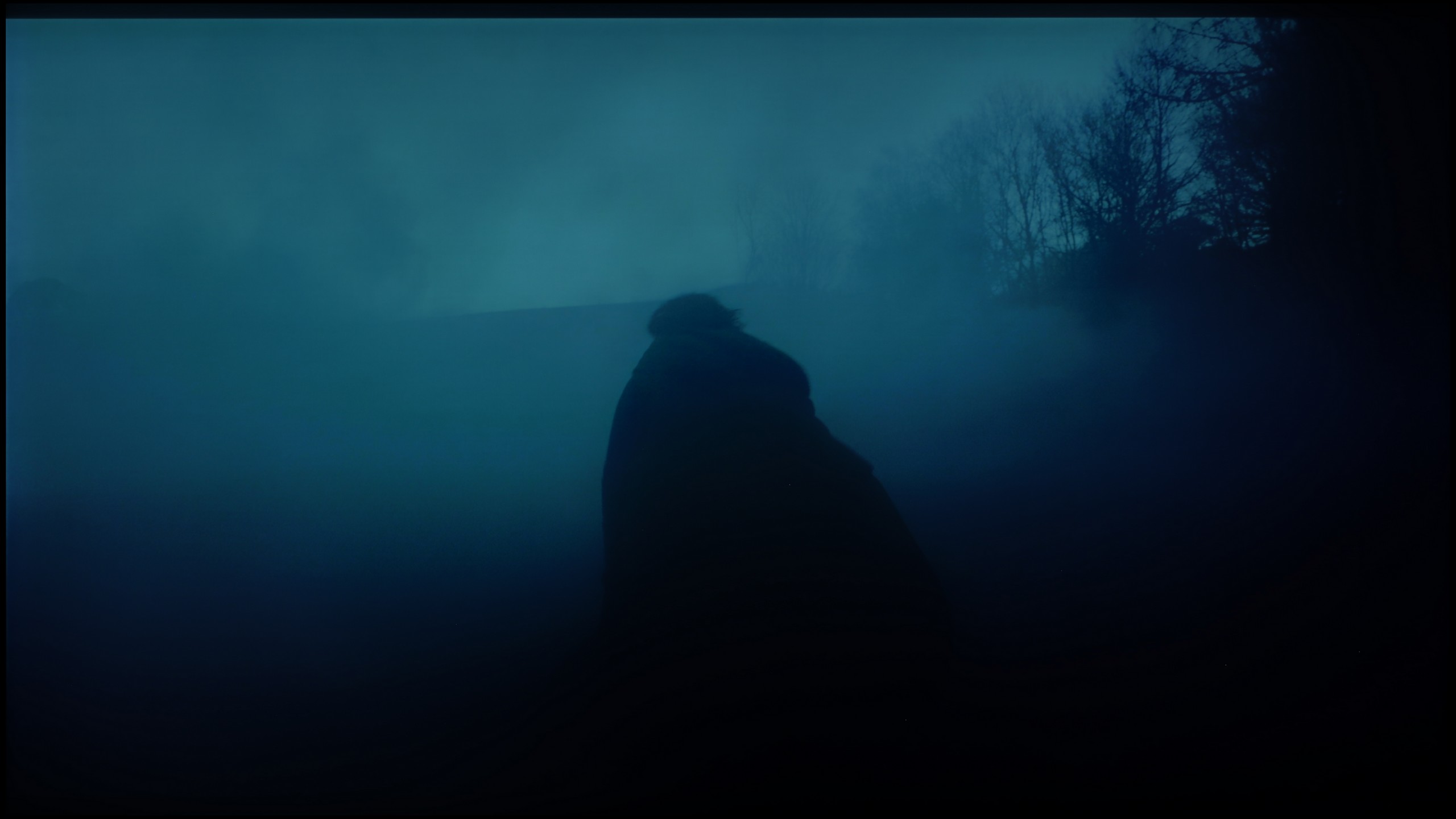






The fluidity of tonal transitions in the TV Samsung QN92D is excellent, making the image appear remarkably natural, without noticeable disturbances. In scenes with complex colour gradations, the TV performs superbly, ensuring smooth and uniform transitions. Competing OLED TVs in a similar price range can successfully take a cue from this, as the Samsung QN92D offers quality that places it on par with models equipped with QD-OLED matrices.
In this respect, the TCL C8K performs really well. Transitions between colours look natural and coherent – there are no strange bands or significant banding that could disrupt the viewing experience. Especially in bright scenes, everything appears very smooth. In the darkest parts of the image, particularly in shades of grey, one can sometimes notice slight unevenness, but they are subtle enough not to be distracting to anyone.
Image scaling and smoothness of tonal transitions
7.2/10
5.5/10
Smooth transition function

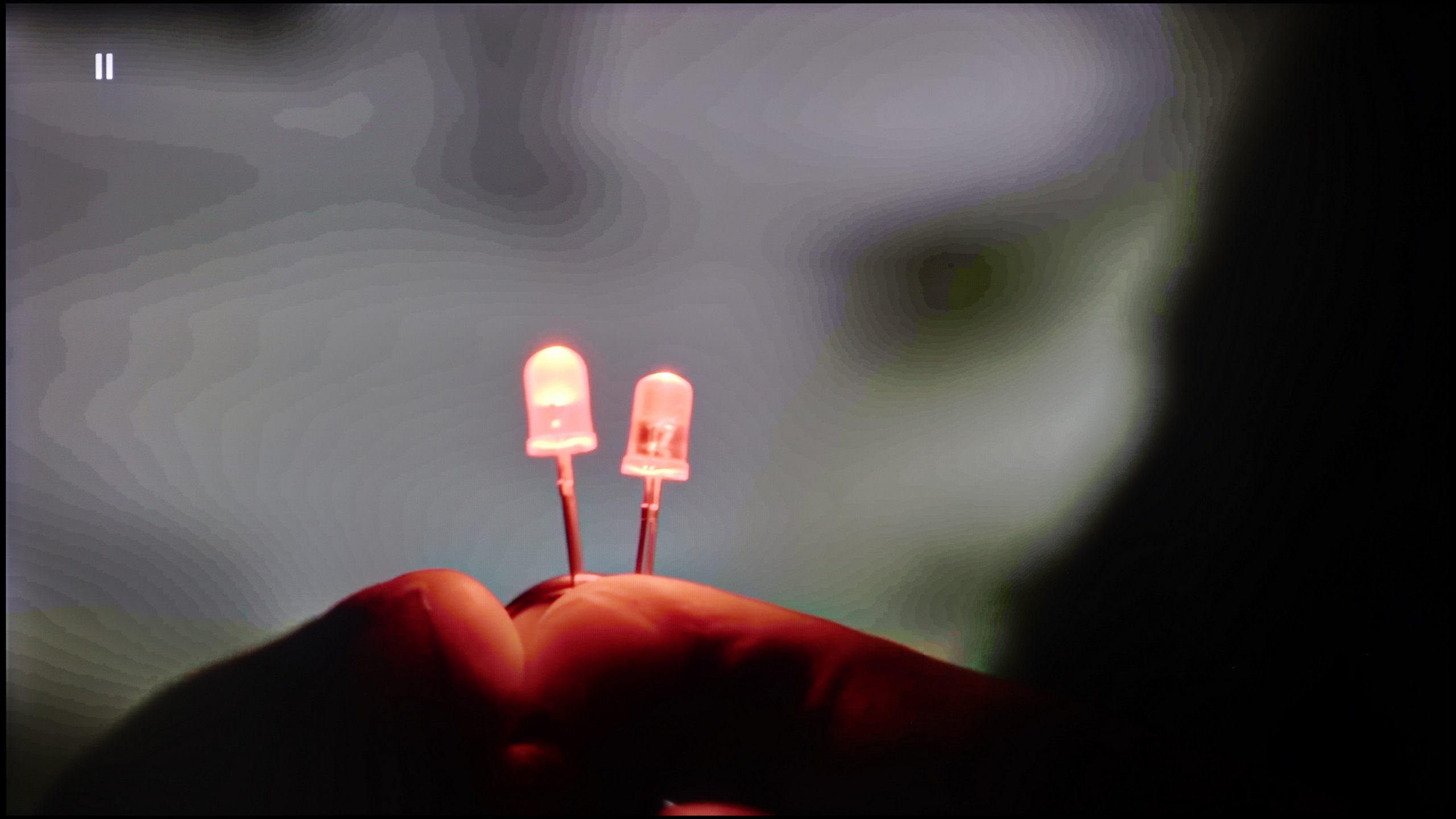
Image without overscan on the SD signal


Let’s check how the Samsung QN92D television performs with tonal transitions in very poor quality materials. The noise reduction feature demonstrates good effectiveness, improving the smoothness of tonal transitions even in challenging conditions. However, it should be noted that, as with other Samsung televisions, the effectiveness of this feature may lead to the removal of desirable elements, such as film grain, which can sometimes affect the authenticity of the image.
Regarding digital processing, the Samsung QN92D television also performs excellently. During testing, the image was presented very well, with the model shown in a natural and correct manner. Details such as branches in the background were reproduced with great precision, highlighting the television's ability to enhance the quality of low-resolution materials.
How does the TCL C8K perform with lower quality content? One could say: reasonably well, though without much enthusiasm. The television offers a tonal transition enhancement feature, which aims to smooth out unwanted gradients. In practice, there is a slight improvement, but it is not at a level that will eliminate all imperfections. The feature subtly softens harsh transitions, but does not perform miracles. Film grain is not completely suppressed, and gentle banding on grey backgrounds can still be noticeable. But perhaps that is for the best? – at least the image does not lose its texture or depth, as can happen with televisions that overdo digital processing. When it comes to upscaling, or enhancing the quality of images from lower resolutions, the C8K performs quite well. The picture is sharp, and details – although sometimes slightly softened – remain readable. However, it is not at the level of the best image processors from the competition. On the plus side, it is worth noting the lack of overscan issues, which is the artificial trimming of the image that can still surprise in some models from other brands.
Blur and motion smoothness
7.5/10
7.8/10

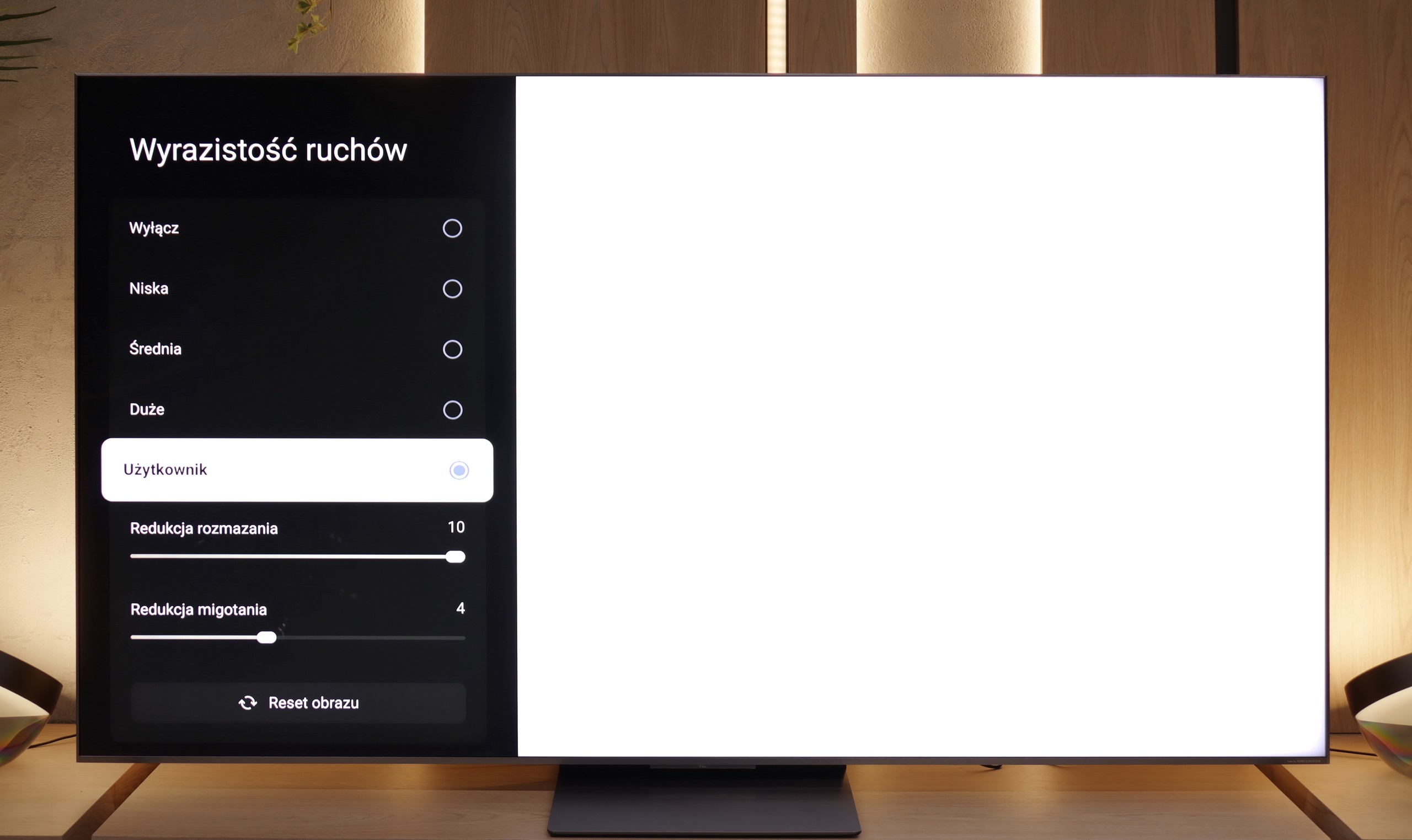
Blur (native resolution, maximum refresh rate):




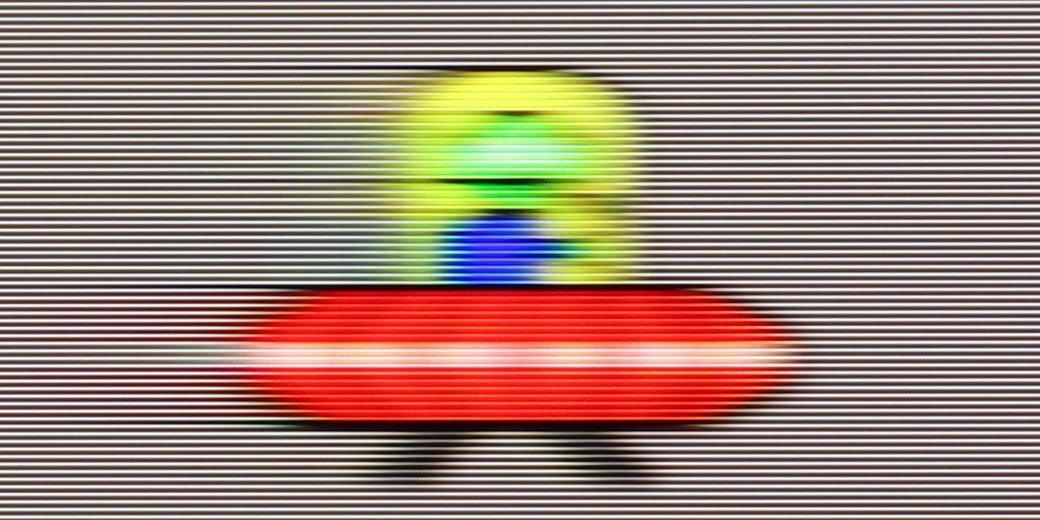
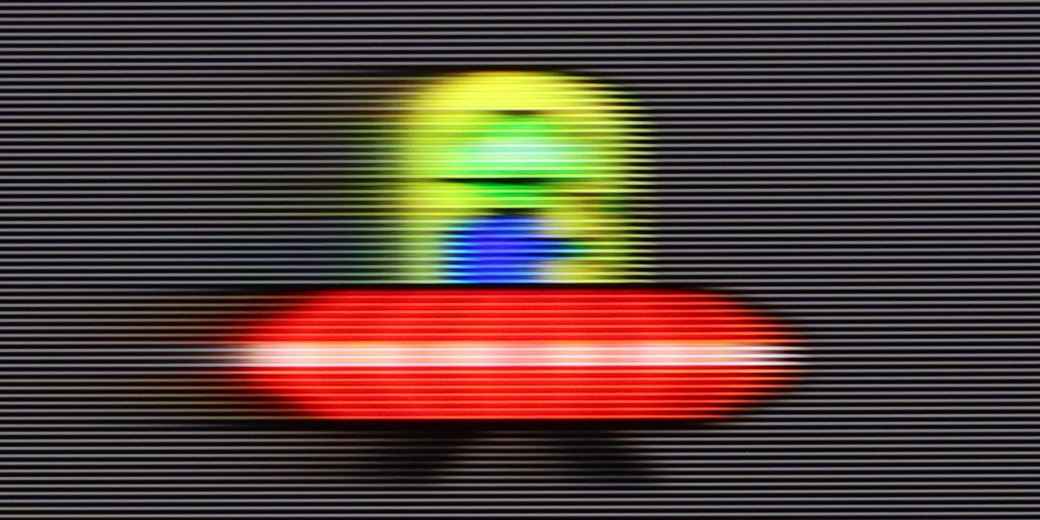
Blur (BFI function enabled):
Image flickers in this mode






Smużenie ():
Smużenie (288HZ 1080p):



The Samsung QN92D television is equipped with a 144 Hz panel; however, when watching content using the smoothness feature, the maximum refresh rate is 120 Hz. This means that both gamers and those who watch a lot of sports will be satisfied with the picture quality. It is also worth mentioning the available image enhancement options, such as the "blur and judder reduction" feature, which allows users to adjust the smoothness to individual preferences on a 10-point scale. Blur reduction is responsible for increasing the sharpness of quickly moving objects, while judder reduction smooths motion, eliminating the "stutter" effect. Thanks to these advanced settings, optimal visual experiences can be achieved, making the Samsung QN92D ideal for both dynamic scenes and intense gaming sessions.
In terms of motion blur, the television performs really well, and it is hard to find anything to criticise. The only comment we might have is a slight overshoot effect noticeable on dark backgrounds during our test with "Ufoludkiem". Nevertheless, with the advanced smoothness settings, the Samsung QN92D is perfect for both dynamic scenes and intense gaming sessions.
If you are planning a weekend with the Champions League or a marathon of F1 races – the TCL C8K won't let you down. The television is equipped with a 144 Hz panel, which means it should handle fast motion well by definition. And indeed – it performs very well. The fluidity of motion is at a very good level here, and the "Motion Clarity" feature with two sliders (motion blur reduction and flicker reduction) makes it easy to adjust the effect to your own preferences. Want to smooth it out a bit – you can. Prefer a cinematic look – no problem.
Console compatibility and gaming features
9.5/10
9.8/10
- ALLM
- VRR
- VRR range48 - 144Hz48 - 288Hz
- Dolby Vision Game Mode
- Correct implementation of HGIG
- 1080p@120Hz
- 1440p@120Hz
- 4K@120Hz
- Game bar

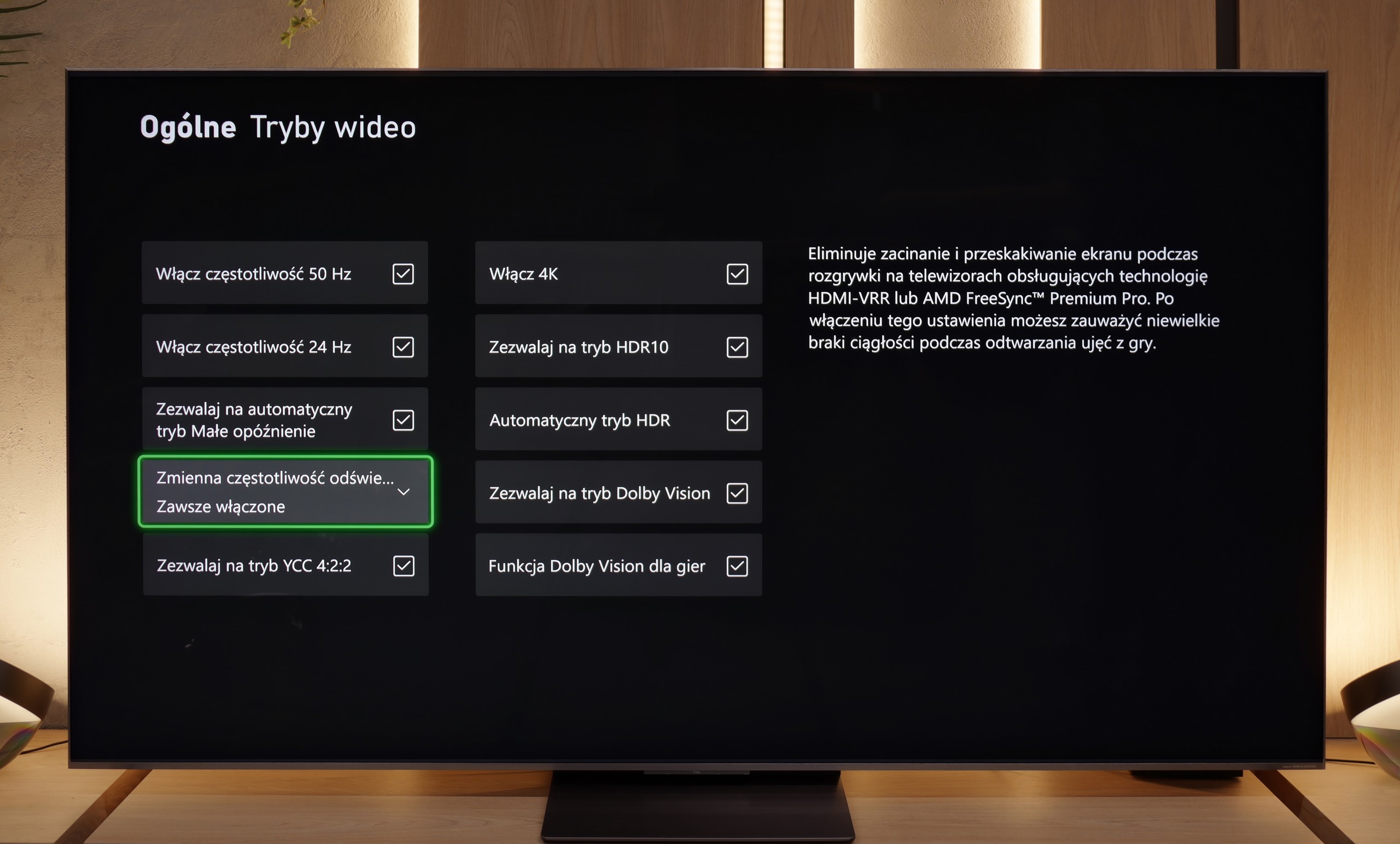

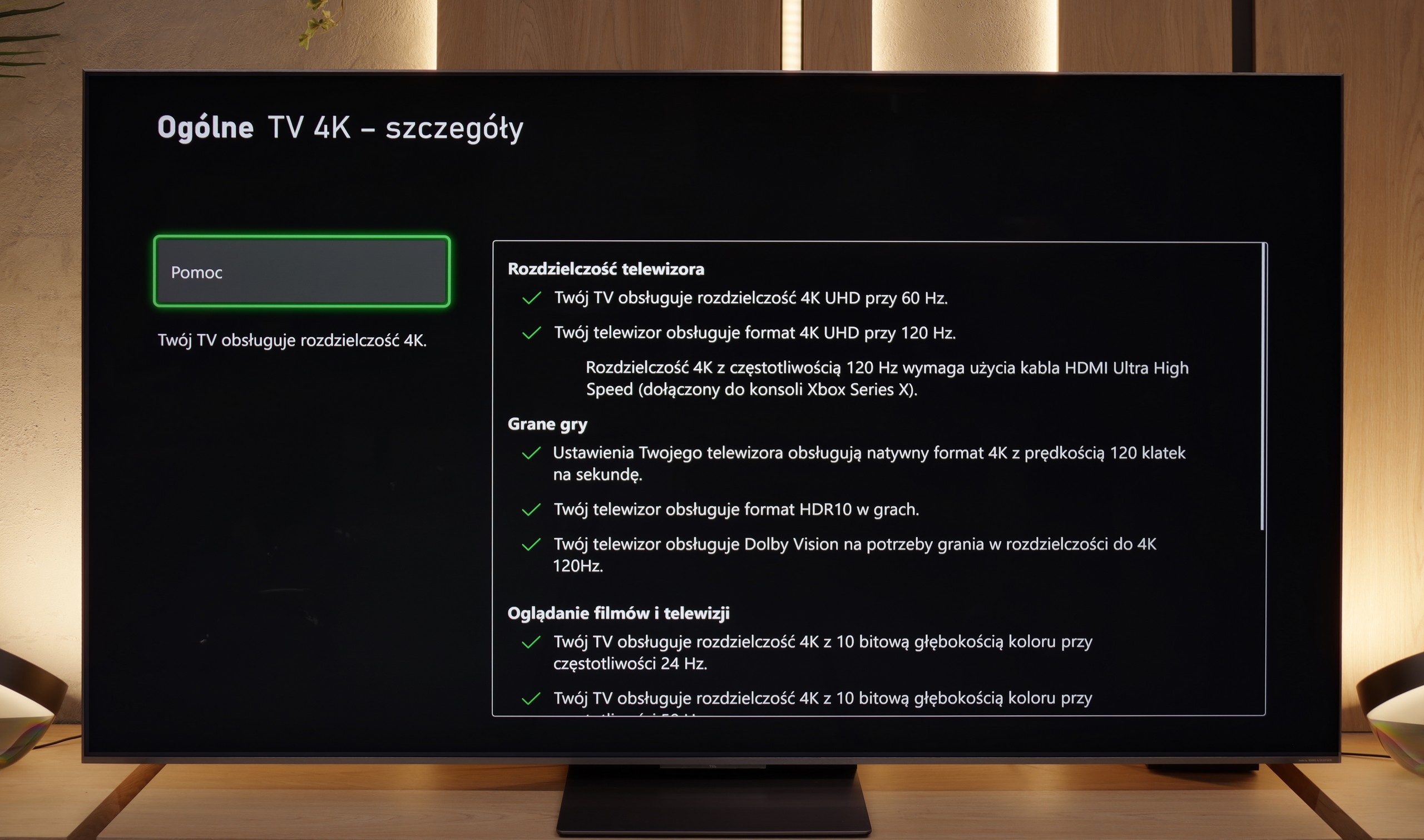

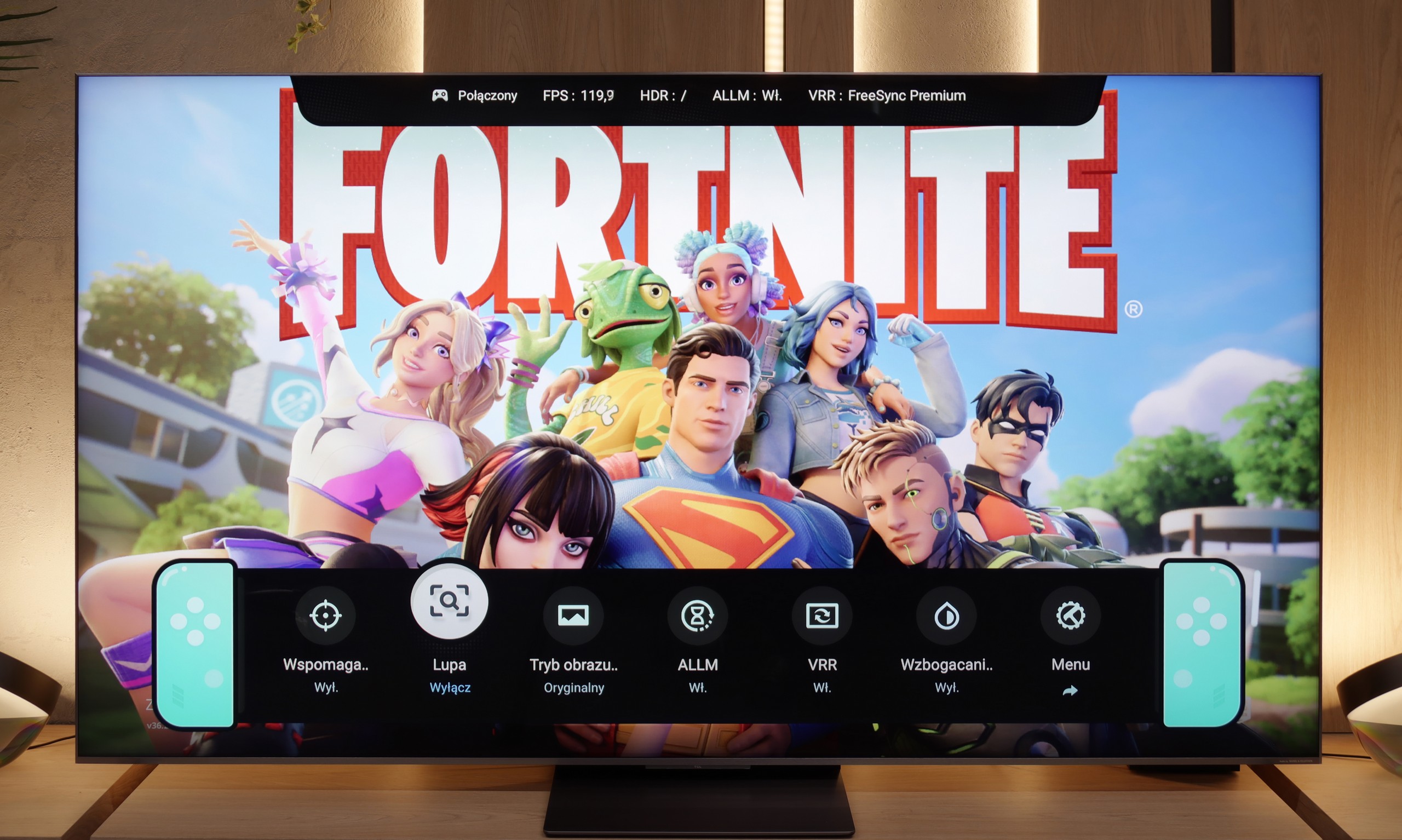

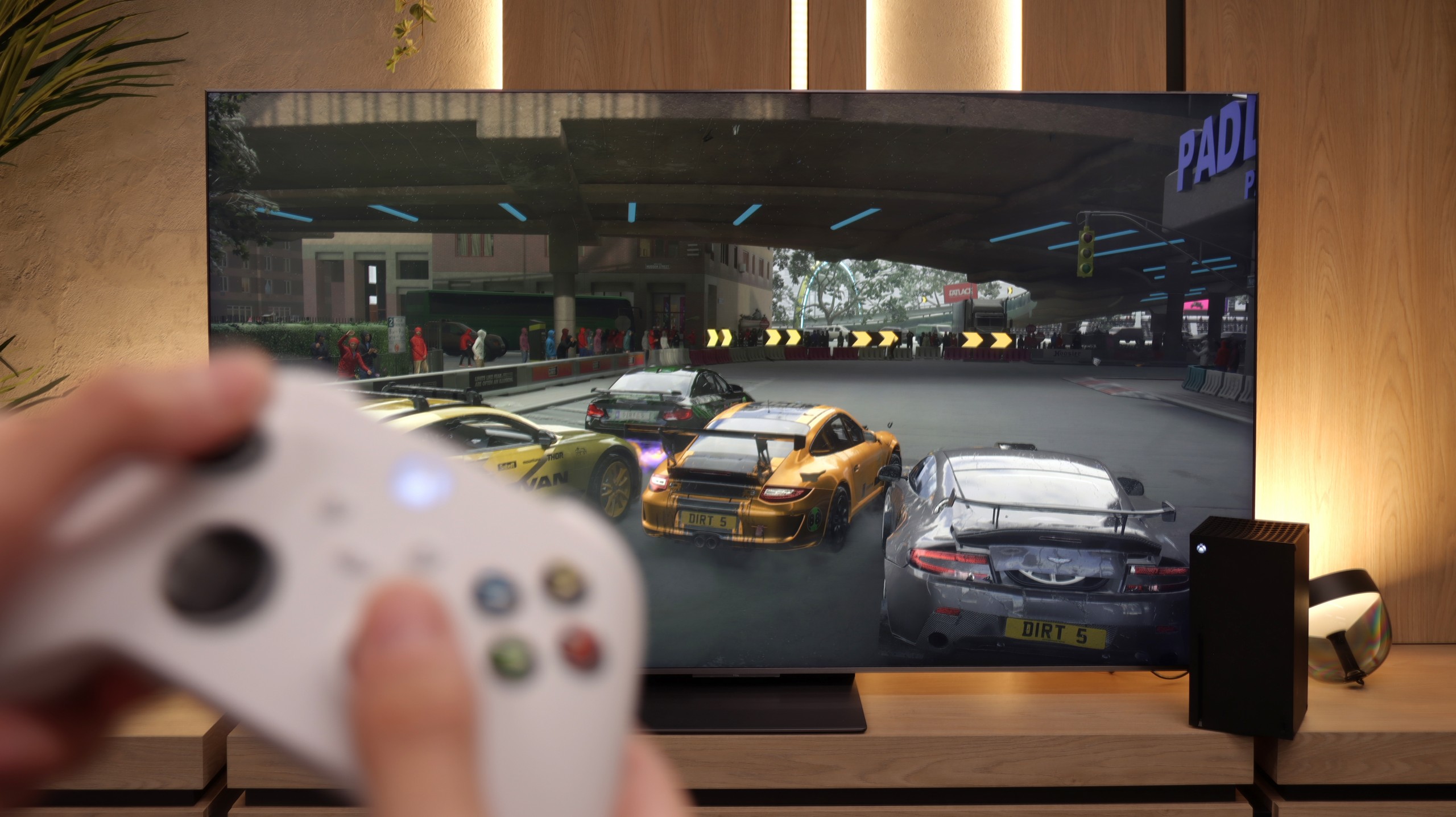
The Samsung QN92/QN90 television is an excellent choice for avid gamers, worthy of the highest recommendations. This model offers virtually all the features available on the market in terms of gaming, making gameplay even more exciting. One of its key features is the 120 Hz panel, which provides exceptional motion smoothness, vital during dynamic action games. The television also has low input lag, ensuring lightning-fast responses to player commands. Additionally, technologies such as VRR (Variable Refresh Rate) and ALLM (Auto Low Latency Mode) adjust the refresh rate and automatically switch the television to game mode, enhancing the gaming experience even further. An additional advantage is the Xbox app, which allows playing favourite titles directly on the television, eliminating the need for a console. This is a typical feature of Samsung televisions, which makes them unique in the gaming world.
Auto Motion Plus Game is a feature that truly deserves praise for Samsung. It is a motion smoother that performs excellently in games, allowing for the perception of a higher frame rate – a 30 frames per second image looks like 45, and 60 Hz becomes close to 90 Hz. Importantly, this feature does not introduce significant lag (input lag does not exceed 25 ms), so it does not negatively affect gaming comfort, unlike many other motion smoothers available on the market. As a result, players can enjoy a significantly smoother image without compromising on responsiveness.
TCL C8K offers practically everything we could expect from a screen for gamers. It features variable refresh rate (VRR), automatic game mode (ALLM), Dolby Vision in games, and a correctly functioning implementation of HGiG, which helps preserve the creators' intentions in HDR titles. The television also supports 120 Hz at lower resolutions without any issues and can even display an astonishing 288 Hz in Full HD – a value that is sure to please fans of dynamic shooters and racing games on PC.
We also find the GameBar – a graphic interface reminiscent of an elongated Nintendo Switch console. It is thanks to this that we gain quick access to information about the current game mode, frame rate, HDR format, and other details that really make life easier for the gamer. Of course, we couldn't resist and launched a couple of races in Forza Horizon on the C8K – and we must admit, it looked and performed really well.
However, there is a slight drawback – in such a fast and evidently gaming device, it is somewhat disappointing that the manufacturer opted for the implementation of only two HDMI 2.1 ports. For some users who utilise several next-generation consoles and, for example, a soundbar with eARC, this might be a certain limitation that is hard to overlook.
Input lag
9.9/10
9.9/10
SDR
HDR
Dolby Vision
The input lag category is crucial for gamers, and the Samsung QN90D performs exceptionally well in this aspect. Input lag values below 13 ms are impressive, which means that the delay between pressing a button on the controller and the response on the screen is minimal. Such a low value allows for smooth and responsive gaming experiences, which is sure to please both casual gamers and professionals for whom every millisecond of reaction time counts. This makes the Samsung QN92D an excellent choice for those who value precision and speed in gameplay.
In terms of delays, the TCL C8K pleasantly surprised us. Whether we were playing in 4K at 60 Hz, 120 Hz, or even in Full HD with Dolby Vision – the input lag remained at a very low level. This is a rare sight, as many televisions lose their advantage here, especially with the more demanding Dolby Vision GAMING picture settings.
Compatibility with PC
8.6/10
8.6/10

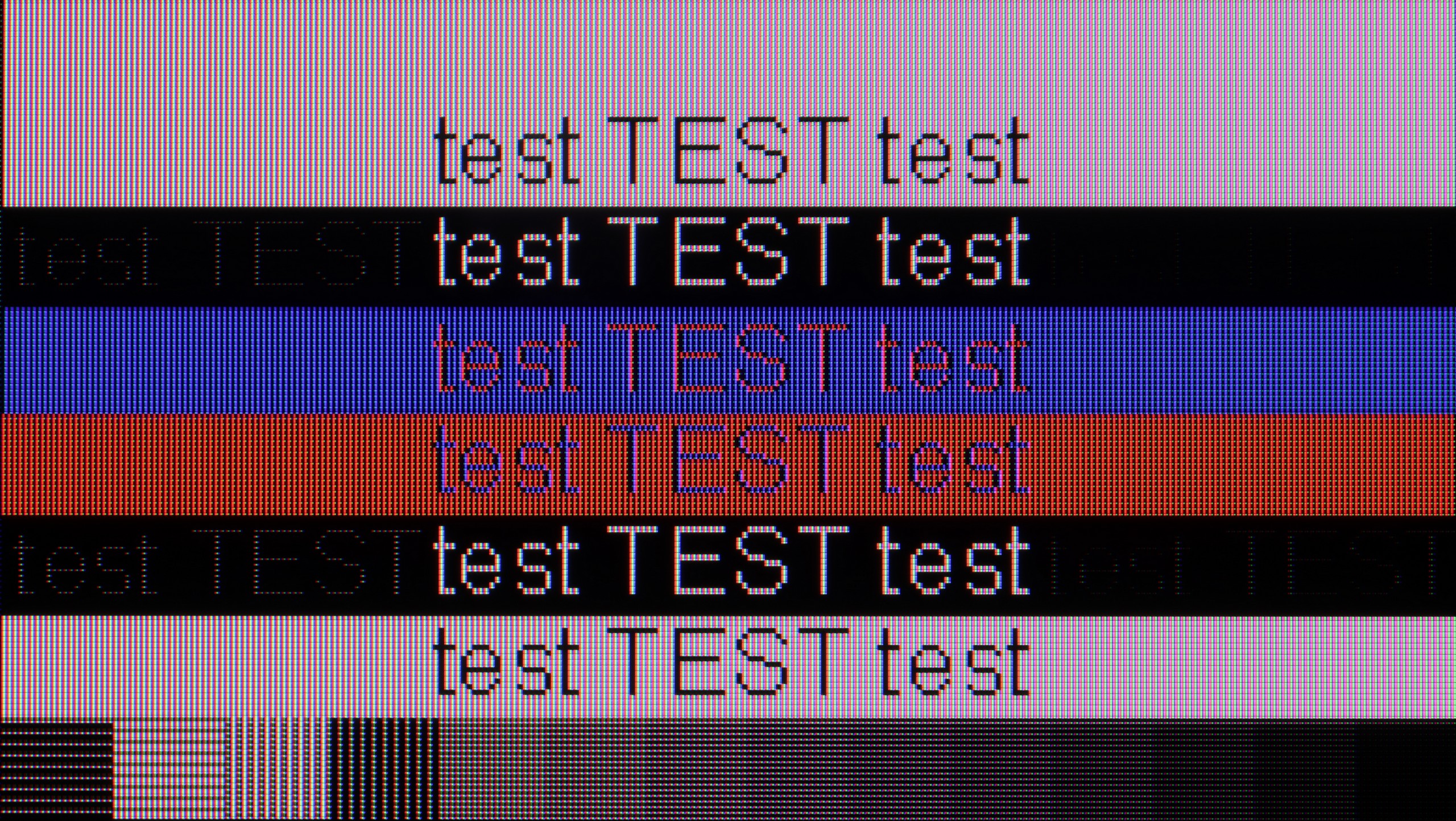
The television stands out with high performance, supporting chroma 4:4:4 and offering exceptionally low input lag. These features allow users to enjoy fluidity and responsiveness, making it an excellent choice for office work and everyday applications. However, one noticeable drawback is the poor visibility of horizontal lines on dark backgrounds. On the test pattern, the letters on the right appear more like vertical lines, which can be frustrating for some users. Nevertheless, the television generally works well with computers, providing comfort in performing daily tasks. It is also worth mentioning in this paragraph the "Remote PC" feature; thanks to Microsoft's collaboration with the Korean giant, we can pair Windows PCs seamlessly and use Office 360 applications.
As we mentioned earlier, the C8K is a television designed with gamers in mind – and not just for console gaming. Connecting a PC is pure pleasure. The low input lag is practically unnoticeable, and the 4K panel at 144 Hz (or even 288 Hz in Full HD) makes gameplay exceptionally smooth. This is the kind of equipment that is really hard to tear yourself away from once you plug in a keyboard and mouse.
Office work and everyday use of the computer are equally impressive. Fonts – regardless of size – are readable and sharp thanks to Chroma 444. However, we have a small note: with very thin horizontal lines, slight imperfections can be noticed. We assume, though, that few will notice this, as hardly anyone plans to place the smallest 65-inch monster 50 cm from their face and use it like a regular monitor.
Viewing angles
7.1/10
4.5/10
In the case of TVs with VA panels, one can usually expect limited viewing angles; however, Samsung QN90D surprises in this category. Thanks to the applied coating that widens the viewing angles, the television offers truly good performance, which is rarely seen in devices with this type of panel. Although VA panels are not usually the best in this regard, in this model the picture remains clear and vibrant even when viewed from the side, making it an excellent choice for larger rooms and group viewing.
One of the novelties in this year's TCL series is the WHVA panel, which has finally made a significant advancement in viewing angles for the Chinese manufacturer. And although you can't completely cheat physics – brightness does indeed drop quite noticeably when viewed from the side – the image itself remains readable and does not drastically lose colours or contrast. This is a considerable change, as VA panels typically fall short compared to IPS panels in this category. Meanwhile, in the C8K, it is evident that TCL has made an effort to ensure that even viewers sitting slightly to the side can still enjoy the full depth of the image – something that will be appreciated by anyone who cannot sit 'in the perfect middle of the sofa'.
TV efficiency during daytime
6.4/10
6.9/10

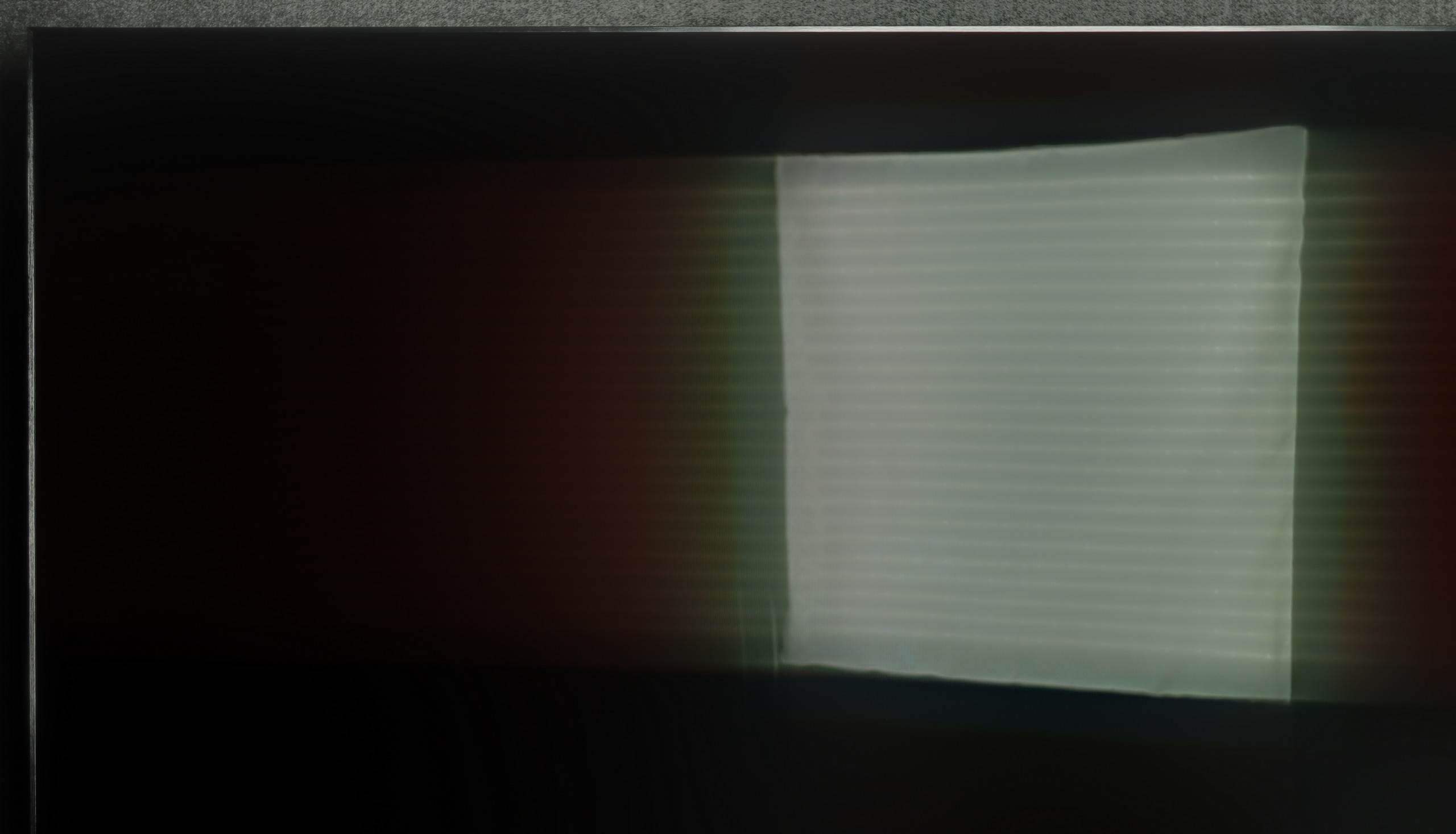


Matrix brightness
Average luminance SDR
TCL C8K: 613 cd/m2
Samsung Neo QLED QN90D / QN92D: 629 cd/m2
The television performs excellently in bright rooms due to its high brightness, especially when watching standard television. A constant brightness level of 600 nits ensures excellent visibility even in intense daylight. Unfortunately, despite the use of a satin finish, handling reflections is average, which may affect viewing comfort. An additional downside is the matrix that improves viewing angles, which causes reflections of sunlight to spread vertically, potentially further reducing viewing comfort in a bright environment.
C8K is truly a bright performer, and not just in theory. In SDR content, it can achieve an impressive 700 nits, which translates to very good image readability even in brightly sunlit rooms. So if you have a bright living room with large windows, this television won't have much trouble with that. However, it is worth mentioning one detail: the WHVA panel used here, with improved viewing angles, causes light reflections to be more diffused sideways. In practice, this means that, for example, wall sconces or floor lamps directly opposite the screen may reflect in a slightly more widespread manner than in typical glossy/satin panels.
Details about the matrix
Subpixel Structure:

Panel uniformity and thermal imaging:


TV features
7.4/10
7.7/10
- HDMI inputs0 x HDMI 2.0, 4 x HDMI 2.1 48Gbps2 x HDMI 2.0, 2 x HDMI 2.1 48Gbps
- OutputsToslink (Optical audio), eARC (HDMI), ARC (HDMI)Toslink (Optical audio), eARC (HDMI), ARC (HDMI)
- Network InterfacesWi-Fi 2.4GHz, Wi-Fi 5GHz, Ethernet (LAN) 100MbpsWi-Fi 2.4GHz, Wi-Fi 5GHz, Ethernet (LAN) 100Mbps
- TV receptionDVB-T, DVB-T2, DVB-S, DVB-S2, DVB-CDVB-T, DVB-T2, DVB-S, DVB-S2, DVB-C
Classic features:
- Recording to USB (terrestrial TV)
- Recording programming
- Picture in Picture (PiP)
- RF remote control (no need to aim at the screen)
- Backlit remote control
- Teletext
- Audio only mode
- Bluetooth headphones support
- Simultaneous Bluetooth headphones & TV audio
Smart features:
- AirPlay
- Screen mirroring (Windows Miracast)
- Voice search
- Voice search in native language
- Ability to connect a keyboard and mouse


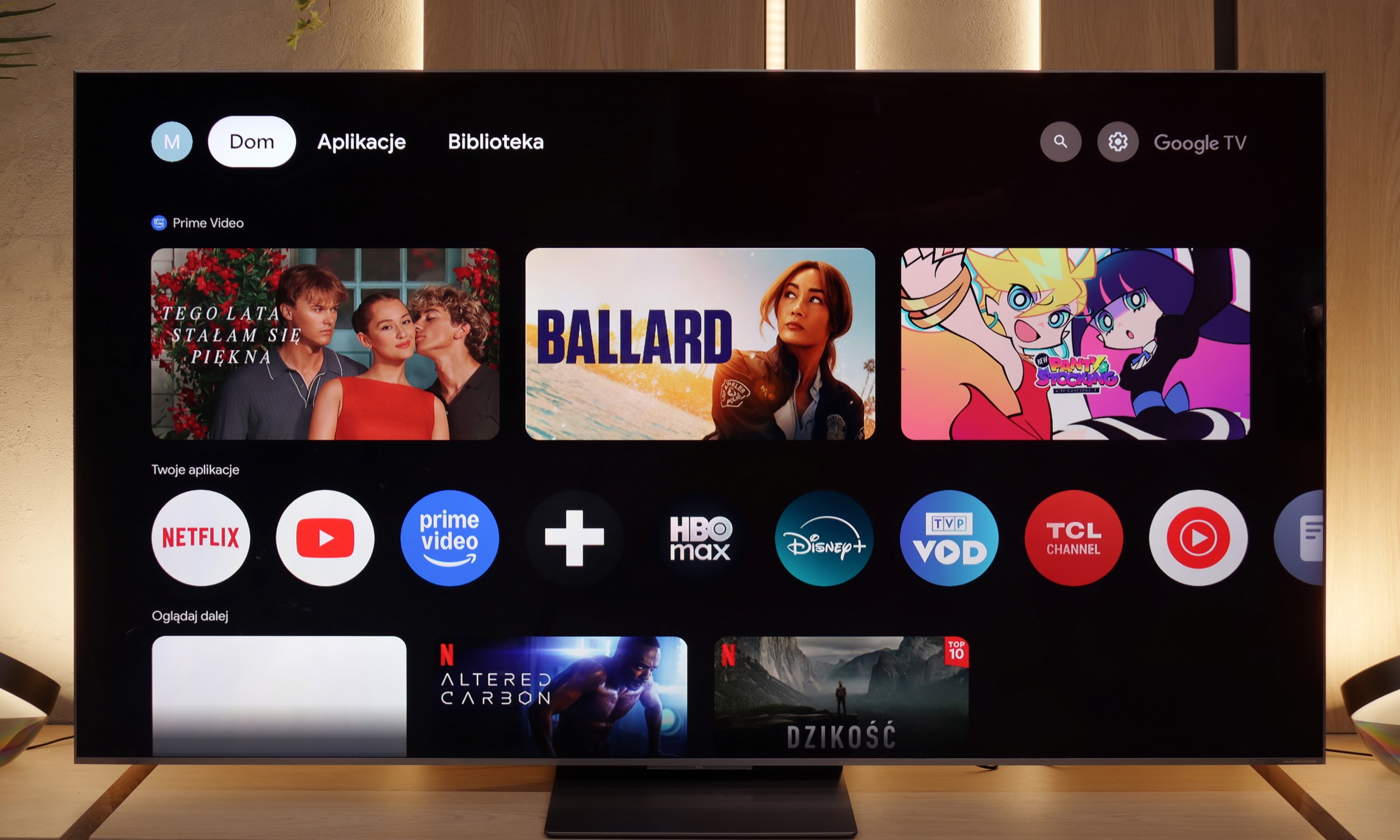
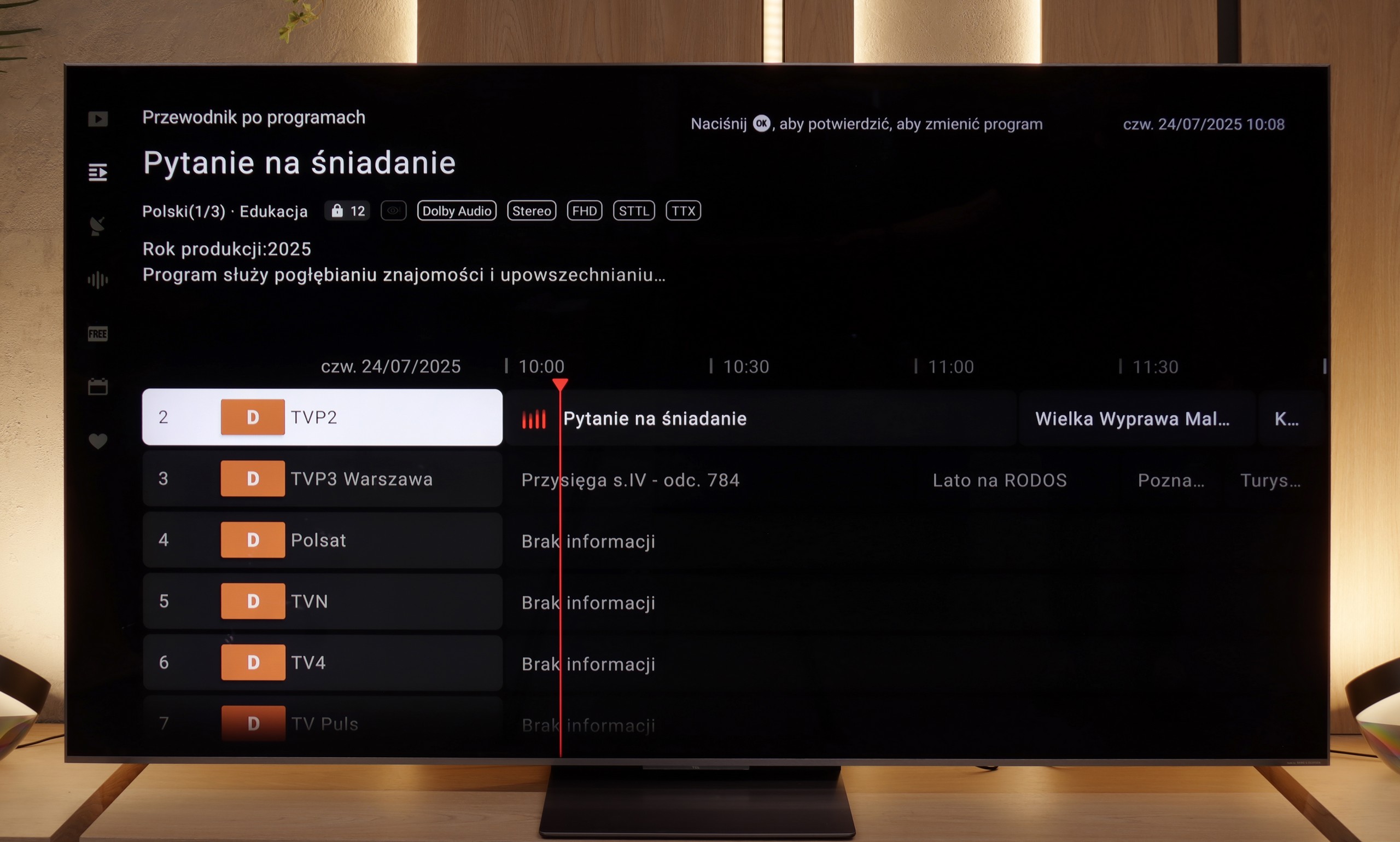
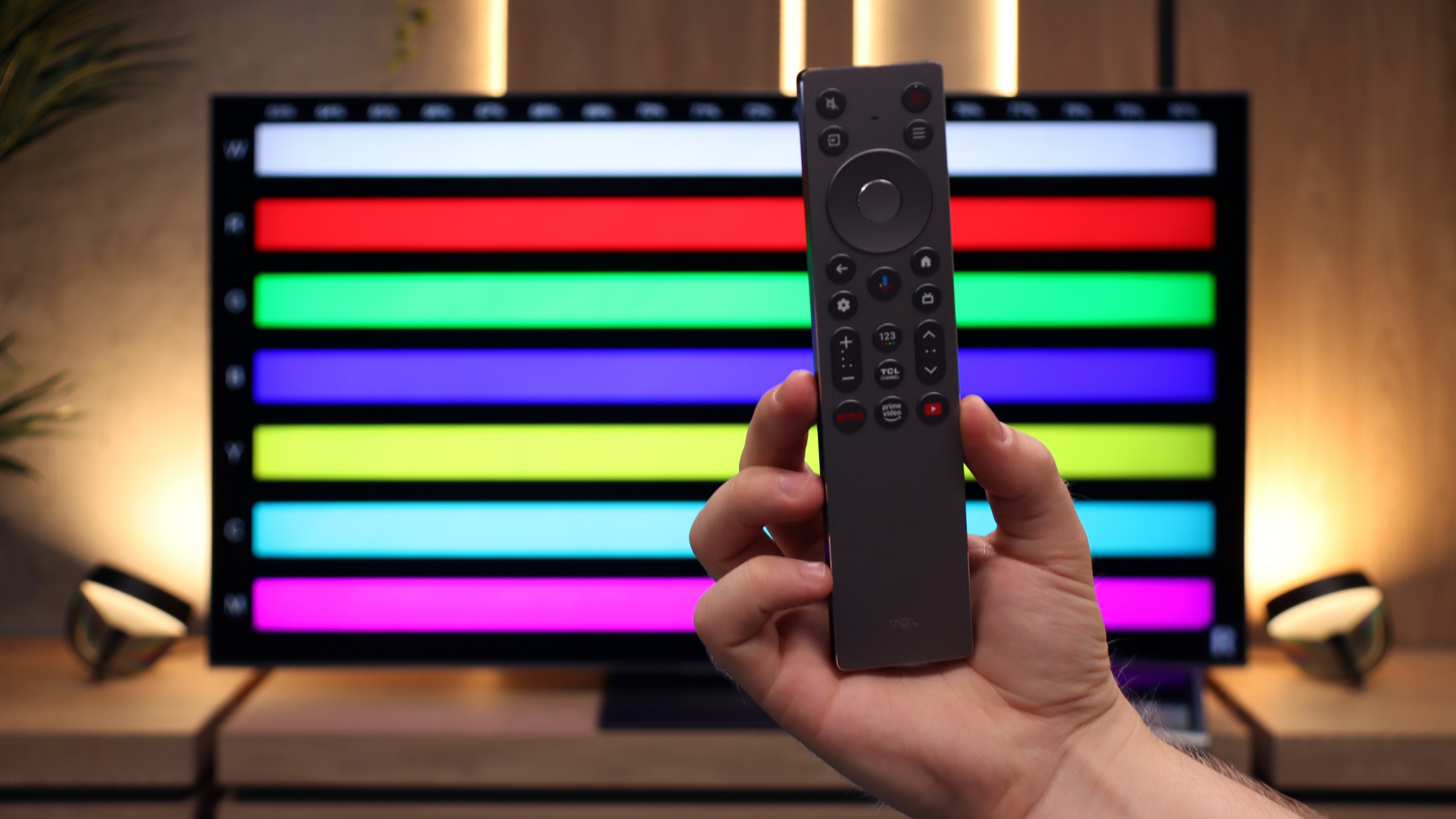
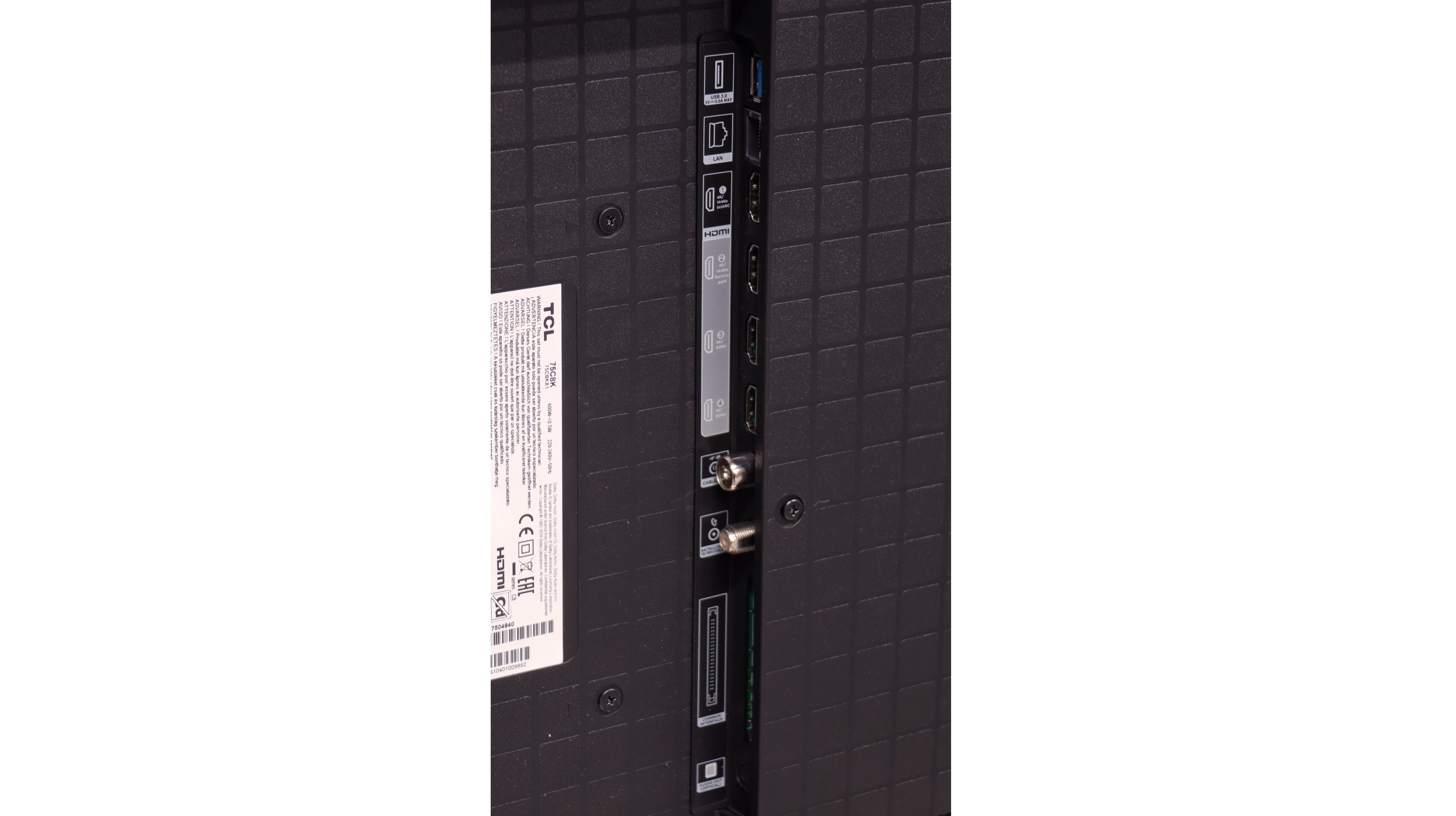
The Samsung QN92D television stands out with its modern Tizen operating system, which offers users an intuitive and visually pleasing environment. Tizen ensures smooth and quick browsing of applications, significantly enhancing the comfort of using the television. With its extensive ecosystem, users can easily connect the QN92D to other devices. The television supports numerous features that facilitate everyday use, such as controlling set-top boxes with the remote, eliminating the need for multiple remotes. Thanks to the AirPlay feature, Apple device users can seamlessly stream media from their iPhone. Additionally, there is a remote PC function that allows users to utilise their computer on a large screen, as well as the Office 365 application, making the QN92D an ideal solution for both work and entertainment.
Furthermore, like many Samsung televisions, the QN92D offers an Ambient Mode feature that allows users to customise the appearance of the television to blend with the surroundings. Users can display a variety of images or information, making the television an elegant part of interior decor even when not in use. Speaking of decor, it is certainly worth mentioning the device's appearance. It is truly very slim, around 2cm at its thickest point, which is impressive. The metal frame undoubtedly gives the impression of a premium device, and the stand included in the package is sturdy.
However, for those using traditional television, the QN92D may prove to be somewhat disappointing, as the Polish market lacks the feature for recording television programmes. Nevertheless, the television offers a PiP (Picture-in-Picture) function that allows simultaneous viewing of two programmes at the same time. The Samsung QN92D is a richly functional television that meets the needs of both gaming enthusiasts and multimedia users, while also aesthetically fitting into modern interiors.
Classic Television Features
The TCL C8K offers the vast majority of features that we consider essential today. It has a classic and clear electronic programme guide (EPG), and teletext features are included, while connecting a keyboard, mouse, or Bluetooth headphones posed no problems at all. It's somewhat unfortunate that the Google TV system – like in many other TCL models – lacks more advanced options, such as programme recording or picture-in-picture (PiP). This may be a drawback for some users, especially if they are accustomed to using these options with other manufacturers. One might also have some reservations about the number of USB ports – there is only one. However, in practice, most people will find it sufficient to connect a drive with movies or a USB stick.
Smart Features
While classic television functions are not the strong suit of the C8K, in terms of smart features, this television truly shines. The Google TV system implemented is the largest and most popular platform on the market – and you can feel it at every turn. The availability of applications is phenomenal. Netflix, YouTube, Disney+, HBO Max, Amazon Prime – all of these can be found here without the slightest problem. Only truly niche or closed ecosystems (e.g. Apple Music) may not be available. The built-in voice assistant works very efficiently – you can ask it to change the channel, launch an application, search for a film, or check the weather. The system responds naturally and quickly, giving a genuine sense of convenience and modernity. It is precisely here that the C8K definitely outpaces a large portion of the competition – after all, that's why we have smart TVs, so that the television does more than just display images.
Playing files from USB
9.1/10
9.2/10
Supported photo formats:
Maximum photo resolution:

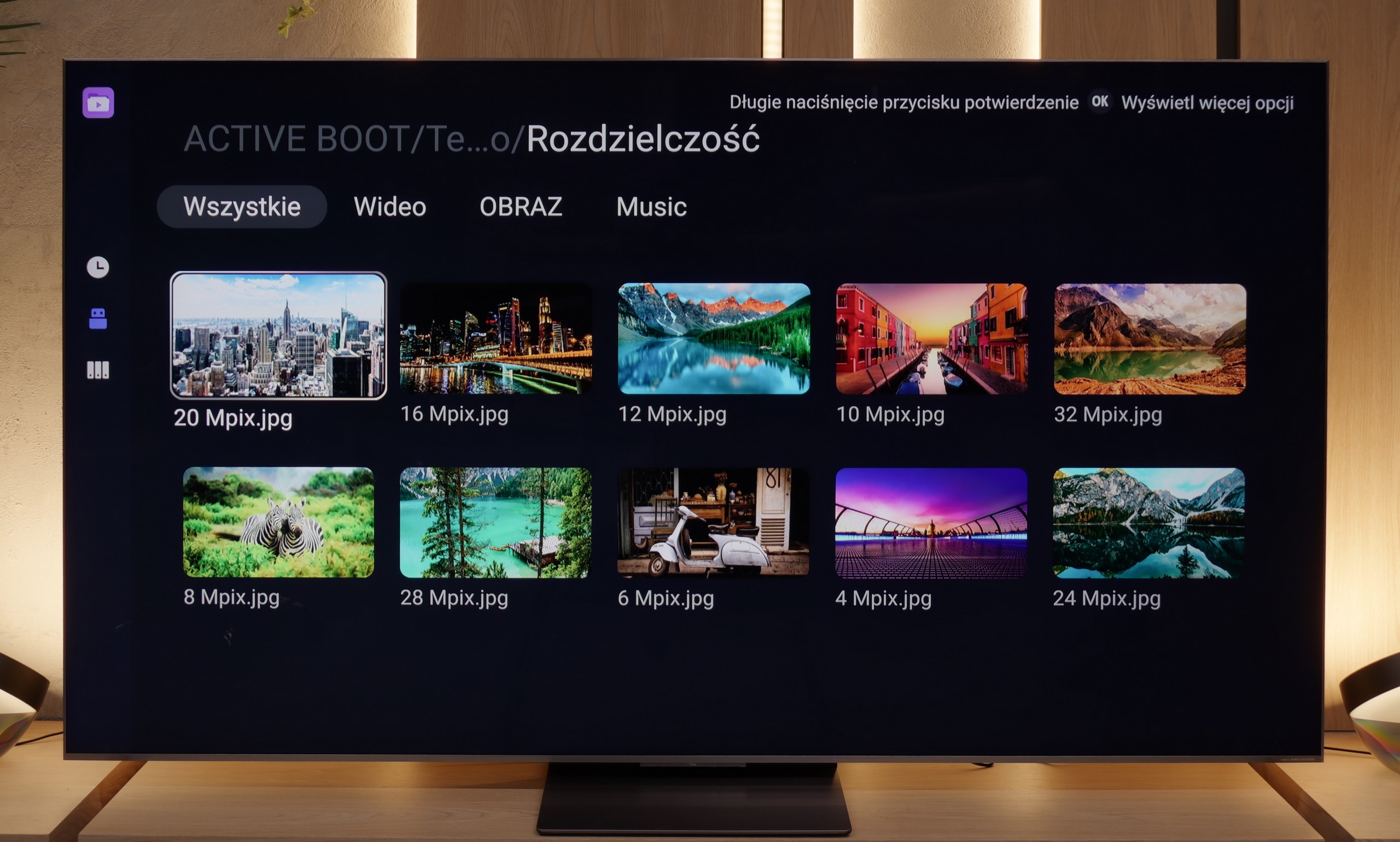
The built-in player in QN90D should satisfy a large portion of users. It will easily play most popular video and audio formats. However, more demanding users may notice some shortcomings – it is not possible to play photos in HEIC format, popular on Apple devices, as well as a few other, less widespread photo formats.
We did not expect miracles, but... we got more than we anticipated. The TCL C8K handled most of the files we put on the USB stick without any issues. Movies in MKV, older AVI, audio tracks in DTS or AC3 – everything worked without a hitch. If we were to nitpick, it would be the usual lack of support for the HEIC format from Apple devices, but that is a standard shortcoming one can live with. The most important thing, however, is that if someone lacks anything, they can simply... install a better player. And this is where the advantage of Google TV is felt.
Apps
8.7/10
9.6/10














































Sound
6.9/10
7.9/10
- Maximum volume-77dB
- Dolby Digital Plus 7.1
- Dolby True HD 7.1
- Dolby Atmos in Dolby Digital Plus (JOC)
- Dolby Atmos in Dolby True HD
- DTS:X in DTS-HD MA
- DTS-HD Master Audio
The television is equipped similarly to the QN95 with a 4.2.2 speaker system with a total power of 70W (the exception here is the 50' variant with a 2.2 layout and the 43' with a 2.0 layout). Despite its very slim casing, the television delivers loud and clear sound, and the overall balance is good. We deducted points as standard, just like with any other Samsung model, for the lack of DTS format support. It is also worth mentioning the proprietary Q-Symphony feature, which allows synchronising the television sound with Samsung's soundbar.
In the case of sound, we typically don't have high expectations. After all, a television is not a Hi-Fi system. But... the C8K pleasantly surprised us. A new feature in the latest top models from TCL is the collaboration with Bang & Olufsen and – most importantly – you can really hear that this isn't just a marketing gimmick. After just a few minutes with the TV, it was clear that it sounds different from a typical "flat screen." The sound is full with a slight but noticeable bass. Of course, we are still talking about sound from a television, so it won't compete with the cheapest soundbar with a subwoofer, but considering the standards of built-in speakers – it is very good.
*During testing at maximum volume, we noticed unusual behaviour in the audio system. With the slider set to 100%, the television reaches around 76–78 dB, but you can hear it trying to generate more power, after which the sound level is immediately adjusted back to the mentioned value. On the other hand, when we lower the volume to, for example, 70%, it initially drops as expected, but after a moment, it slowly rises back to the same level of 76 dB. This effect gives the impression of an aggressive limiter that always brings the volume down to a single level, regardless of the position of the slider. We checked this behaviour multiple times and in each case, the result was identical – no additional functions of "intelligent" volume adjustment or AI were active.
Acoustic Measurements
No acoustic data
77dBC (Max)
75dBC


